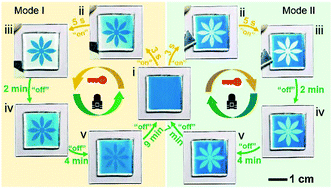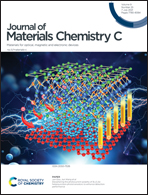Self-powered quasi-solid-state electrochromic devices for optical information encryption†
Abstract
Self-powered electrochromic devices (ECDs) without an external power supply have been attracting extensive attention owing to their great potential in diverse electronic areas. However, conventional self-powered ECDs generally suffer from a complicated configuration, inflexibility, and poor color switching properties. Here, we develop a flexible self-powered quasi-solid-state ECD with a simplified bilayer film configuration based on a cathodic Prussian blue film and an ionic hydrogel film, in which an aluminum wire acts as both the conductive circuit and anode material. Owing to the elaborate bilayer structure and unique ionic hydrogel film, the self-powered ECD exhibits a high color switching speed, high reversibility and a tunable coloration rate on demand. Impressively, the ECD possesses the capability of “reviving” its color switching properties after repeated cycling, which significantly extends its lifetime. Taking advantage of the outstanding color switching properties, simple fabrication process, and straightforward operation, we demonstrated the practical applications of self-powered ECDs in optical information encryption and decryption. These findings may open up a new way to design self-powered ECDs with new functions and thus explore new applications.



 Please wait while we load your content...
Please wait while we load your content...